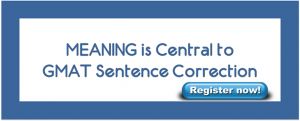Mystery123 wrote:
GMATNinja @EmpowerGmat
Could do you do the analysis of this question, please?
I have followed your posts and I think that your explanations are the best I have found at the GmatClub. Thanks
Thanks
Mystery123 for the kind words, and I apologize for the delayed response!
I'm not sure I have a whole lot to add on this one, though. As already discussed, choices (C), (D), and (E) are all sentence fragments. The subject of each sentence is "the Kensington Rune Stone", but none of those options gives us a main verb for that subject:
Quote:
(C) said to have recorded an encounter between Native Americans and Norse explorers in 1362, and thus cited as evidence for European exploration of
Here we essentially have, "... the Kensington Rune Stone, a slab of rock, said to have recorded {...} and thus cited as evidence." If we strip out the modifiers, we basically have: "The Kensington Rune Stone...
said to have recorded and
cited as evidence."
In this sentence, "said" and "cited" are just modifiers (specifically participles, if you like grammar jargon) that modify "the Kensington Rune Stone".... so we basically have the subject of the sentence ("Kensington Rune Stone") and a whole bunch of modifiers.
In other words: there is no main verb for the subject, so we have a sentence fragment. Eliminate (C).
Quote:
(D) which was said to record an encounter between Native Americans and Norse explorers in 1362, and thus cited as evidence that Europeans explored
(D) has a similar issue. We have, "... the Kensington Rune Stone, a slab of rock, which was said to record {...} and thus cited as evidence." Stripping out the modifiers, we're left with, "The Kensington Rune Stone,
which was said to record and cited as evidence."
The phrase beginning with "which" is just a noun modifier (modifying the "Kensington Rune Stone"), so we basically have the subject of the sentence ("Kensington Rune Stone") and a bunch of modifiers. Again, there is no main verb for the subject, leaving us with another sentence fragment. Eliminate (D).
Quote:
(E) which, said to have recorded an encounter between Native Americans and Norse explorers in 1362, was thus cited as evidence for Europeans exploring
You can probably guess what I'm going to say about (E). This time, we have "... the Kensington Rune Stone, a slab of rock, which, said to have recorded {...}, was thus cited as evidence." Stripping this down further, we have, "The Kensington Rune Stone, which was cited as evidence."
Again, we have the subject and a bunch of modifiers, but we do not have a main verb. (E) is another sentence fragment, so it can be eliminated.
So we're left with (A) and (B).
mikemcgarry did an excellent job explaining why (B) is wrong in
this post, but I'll add a few additional thoughts:
Quote:
(A) was said to have recorded an encounter between Native Americans and Norse explorers in 1362 and thus was cited as evidence that Europeans explored
(B) was said to record an encounter between Native Americans and Norse explorers in 1362, thus being cited as evidence for European exploration of
We could probably drive ourselves nuts discussing the difference between "was said to have recorded" or "was said to record" -- honestly, I'm not sure that either of those is clearly WRONG, exactly.
The bigger issue is that (A) uses "thus was cited" while (B) uses "thus being cited". In (A), we have a parallel list of verbs: "... the Kensington Rune Stone 1) was said... and 2) was cited..." The parallelism looks great, because it's clear that the stone accomplished two things: it "was said to have recorded an encounter" and it "was cited as evidence that Europeans explored North America..." Cool.
I can't make any sense of the phrase beginning with "being" in (B), though. There are cases when "being" is completely fine, but in this case, I think it's trying to modify the entire previous clause, and that's generally not an acceptable use of "being" on the GMAT. (More on "being" in
this article.) Besides, it just doesn't make a lot of sense meaning-wise: I'm having a hard time understanding how the phrase "...being cited as evidence for European exploration..." modifies the previous clause "...the Kensington Rune Stone... was said to record an encounter..."
That seems like a pretty solid reason to ditch (B) and stick with (A).
I hope that helps!



 15%
(low)
15%
(low)
 22%
(01:47)
wrong
22%
(01:47)
wrong  based on 1114
sessions
based on 1114
sessions










